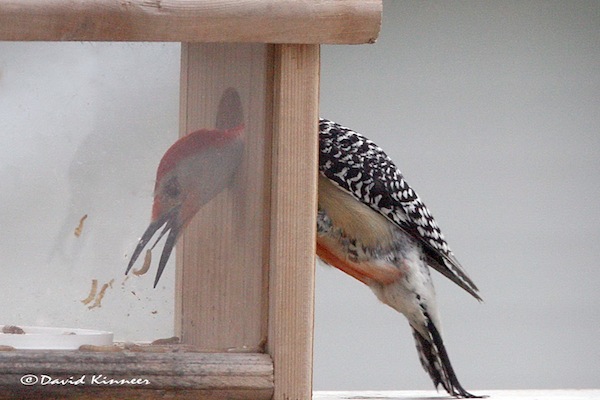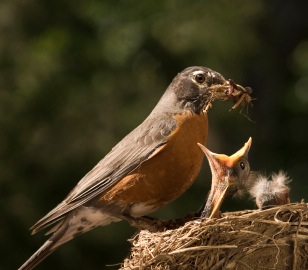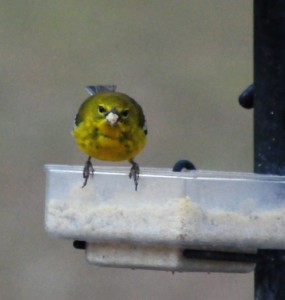-
new guests at the mealworm feeder
Killer photo… thanks David for letting us use it for this post. A red bellied woodpecker spears a snack of worms with that long tongue!
The conversation centered around this photo had nothing to with mealworm feeders, but rather birds’ tongues. Yup, of all bird species, it’s only the woodpecker and hummingbird who can actually stick out their tongue! And the limited range of movement is straight forward at that.
Box, dish, tray, cup, cage, staked, hanging, pole-mount and so on… there all kinds of feeders for offering mealworms. Live worms may find escape from open feeders, but it’s not the only reason the box or cage styles are popular. Just about every bird around will eat your worms (and pretty darn fast), so if the intention is feeding bluebirds… enclosed models are basically referred to as bluebird feeders, and they may be hung, pole-, or post-mounted.
This kind of mealworm feeder keeps most birds out, as very few will actually enter a box to retrieve food. The entry/exit is sized the same as that of a bluebird house, although chickadees, carolina wrens and nuthatches will use these feeders if/when live worms are discovered!
In our quest for bluebirds several years ago, housing and fresh water didn’t seem like enough. Up went the mealworm feeder, with every kind of bluebird food out there! It wasn’t until live worms became available on a daily basis the blues finally stuck around. Since then, a Gilbertson nest box and a another NABS approved wooden house have hosted many successful broods over the years. It takes an open habitat, with good perches for hunting insects. As for the hawks who nest nearby in the woods… we could all do without them 🙁 By the way, three woodpecker species totally ignore both open-dish mealworm feeders in our yard, preferring suet and nuts over live worms. Just one of the many reasons we found this photo so very cool!
-
Smart Robin Sits Under the Mealworm Feeder!
Pretty smart robin… since she can’t enter the traditional fly-in mealworm feeder, she sits directly below it on the ground and waits for escaped worms to drop! Imagine my surprise when I glanced out the window and saw her with a huge mouthful of something… my worms! But she’s got nestlings to feed as well, so hey-whatever works.
Normally live worms are reserved for the bluebirds, but the heat and drought covering most of the country makes it extremely difficult on most wildlife. Actually, crickets, spiders and grasshoppers thrive in these dryer conditions, making it easier for bluebirds and other insect feeding birds. Robins on the other hand, thrive when soils are moist, making their preferred foods more abundant.
One mealworm feeder is an open dish style, that’s where the baby blues first learn to eat on their own. It takes some extra time for them to learn the fly-in feeder. These look more like houses, the worms are inside and there are several entry/exit holes. Luckily nobody else (except for Carolina Wrens) ventures into the feeder. Live worms aren’t too terribly expensive… it’s the shipping that hurts your wallet! Not only must they be shipped via overnight service, but due to high temps, they must be shipped in coolers. This adds size and weight to the delivery-bumping the price even higher. Oh… what we don’t do for our birds!
By the way, during nesting season, it is advised to add calcium if you are supplementing with live worms. Some folks use crushed eggshells, but I’ve never been successful with them. Calcium Carbonate (powder) is inexpensive, and simple to use with worms. Just shake some on the worms to lightly “dust” them prior to feeding. The calcium helps females from becoming egg-bound – eggs actually get stuck in the canal-and it’s fatal too. It also helps fledgelings grow strong bones for a better chance of survival.
- Bird Accessories, Bird Feeders, Birding Accessories, Bluebird Feeders, Fruit, Jelly & Mealworm Feeders, Mealworm Feeder, Uncategorized, Wild Bird Feeders
The dish style mealworm feeder offers various feed options
Hey lady! What’s up with the Mealworm Feeder?
This little plexiglass dish get big traffic in our yard! When live mealworms are placed in it (most times twice a day) all bets are off. The bird traffic is fast and furious, first come, first served!
Originally meant for our Bluebirds – the Chickadees and Titmice quickly learned of the treasure. So, the Bluebirds soon received their own enclosed mealworm feeder, although Carolina Wrens have since figured that out as well!
Feeding live worms can get expensive when everybody’s in on the coveted treat, and I mean everybody! Even the Robins get a few worms in a glass dish that’s left on the ground. And I can’t stand when the crows get to them first!
Unless you have the time and patience to cultivate your own worms, ordering in bulk quantities is easier on the wallet. The worms really aren’t that expensive… it’s the shipping that gets ya! Since they’re live, overnight delivery is required for warmer temperatures. For a few months out of the year (depending on your location) a second-day delivery works fine.
Gradually decreasing the amount of worms, and adding a home-made suet mixture in this meal worm feeder landed a “so-so” reaction from most of our beaked buddies. This Pine Warbler has a mouthful of the stuff, (which is why his beak looks fat & white) but just look at that expression! It’s like “excuse me, where are my worms?”
This mealworm dish actually has drainage, but many similar styles do not, making them perfect for offering water too. In summer, fresh fruit is a great choice for migratory birds, while suet mixtures & crumbles, and shelled peanuts are good options for cold weather feeding.
Offering live worms has created a whole new dimension to our backyard birding experiences. Definitely worth giving it a try if you’ve never fed them before, especially if bluebirds are in the area. And Robins adore them too! But if you don’t want the birds eating you out of house and home… a more traditional, or enclosed mealworm feeder may be your better choice.

 Killer photo… thanks David for letting us use it for this post. A red bellied woodpecker spears a snack of worms with that long tongue!
Killer photo… thanks David for letting us use it for this post. A red bellied woodpecker spears a snack of worms with that long tongue!
